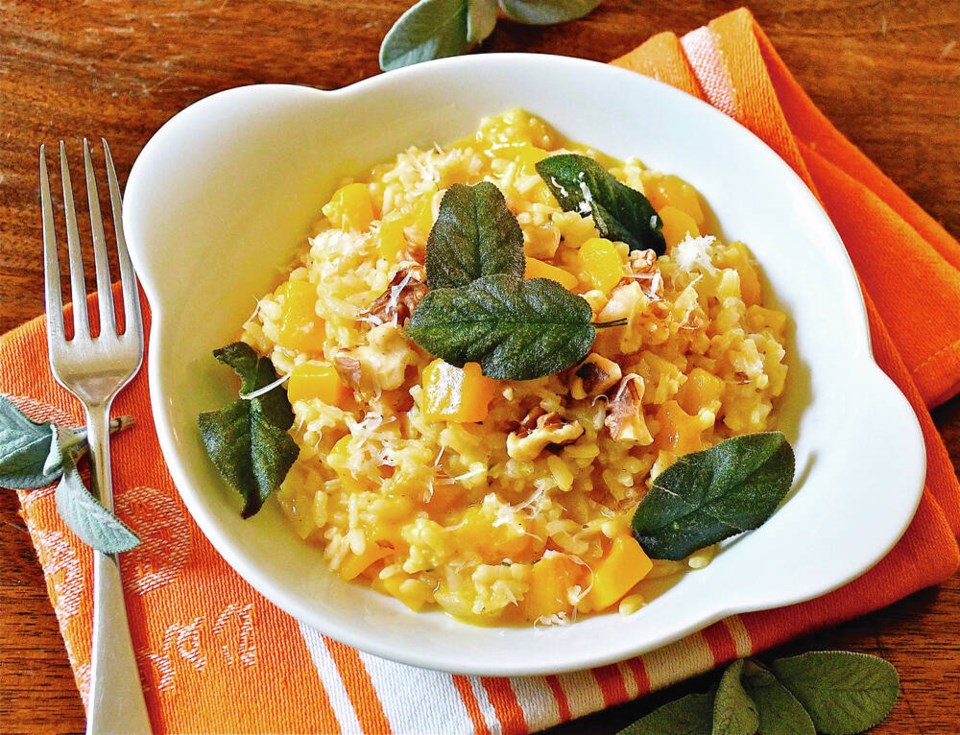At first glance, seeing rice and squash on your kitchen counter may not lead you to think they could star in a toothsome autumn meal. But when they’re turned into comforting butternut squash risotto, that’s exactly what occurs.
The rice needed for this dish are short- to medium-grain varieties sold at grocery stores and Mediterranean/specialty food stores. They’ll be labelled by the specific variety risotto rice, such as arborio, carnaroli or vialone nano. Some brands also generically label their product and simply call it “risotto rice” or “Italian rice.”
All those types of rice have high starch content and absorb less liquid during cooking; qualities that allow the rice to maintain a pleasing texture and develop an almost creamy appearance when cooked.
To make my butternut squash risotto, you sauté cubes of peeled squash and diced onion until softened. The rice is added and cooked until lightly toasted. Garlic and white wine are added to the pot and the wine is reduced until almost evaporated. You then start slowly adding stock to the rice, pouring in more of it once the last amount you added has almost been completely absorbed by the rice.
When cooked, grated Parmesan cheese, a bit of butter, if using, and seasonings are mixed into the risotto. And when served, bowls of it are topped with toasted walnuts and, if desired, crispy, fried sage leaves, creating a flavourful, seasonal meal.
Butternut Squash Risotto with Walnuts and Sage
This risotto, rich with tender bits of squash, is perfect for autumn. Serve as a main course with, if desired, a side salad and some crusty Italian bread.
Preparation time: 25 minutes
Cooking time: about 40 minutes
Makes: three servings
3 1/2 cups low sodium vegetable or chicken stock or broth
2 Tbsp olive oil
1 1/4 cups peeled butternut squash, cut into small cubes (see Note 1 and Eric’s options)
1/2 cup finely diced onion
1 cup risotto rice
1 medium garlic clove, minced
1/3 cup white wine
1/2 cup freshly grated Parmesan cheese, plus some for the table
1 tsp finely chopped fresh sage (see Note 2)
2 tsp soft butter (optional)
• salt and freshly ground black pepper, to taste
3 to 4 Tbsp walnut pieces, toasted (see Note 3)
12 to 15 medium to large, crispy, fried sage leaves (optional)
Place stock in a pot and bring to a simmer over medium-high heat. When simmering, turn heat to its lowest setting.
Heat oil in a second pot (mine was eight inches wide) set over medium, medium-high heat. Add squash and onion and cook until softened, four to five minutes. Add rice and cook, stirring, for three to four minutes, until rice has a slightly nutty, toasted aroma.
Mix garlic into the rice, and then pour in the wine, lowering the heat so that it very gently simmers. Simmer until the wine is almost fully absorbed by the rice. Add 1/2 cup of the stock (or broth), bring it to a simmer and cook until it’s almost fully absorbed by the rice.
Add remaining stock (or broth), 1/2 cup at a time, cooking and stirring until it’s almost absorbed by the rice before making the next addition. You may not need all the stock (or broth) to cook the rice, which can take 25 to 30 minutes.
When rice is tender and creamy looking, stir in the 1/2 cup cheese, chopped sage and butter, if using. Season the risotto with salt and pepper.
To serve, divide risotto between warm, shallow serving bowls. Top each serving with some walnuts, garnish with crispy sage leaves, if using, and serve with more freshly grated Parmesan cheese, for sprinkling on at the table.
Note 1: Cut the squash into small, 1/2-inch cubes. If cut larger than that they won’t be cooked through when the risotto is ready.
Note 2: Fresh sage is sold at most supermarkets.
Note 3: To toast walnuts, place in a skillet and set over medium heat. Heat and stir until lightly toasted, about five minutes.
Note 4: To make crispy fried sage leaves, pour 2 to 3 Tbsp olive oil in a large skillet set over medium-high heat. When oil is hot, add 12 to 15 fresh sage leaves and cook until they become crispy on the underside, about one minute. Turn each sage leaf over and cook 30 to 60 seconds more. Lift sage out of the skillet, set on paper towel to drain and set aside until needed.
Eric’s options: Other types of hard shell (winter) squash will also work in this recipe.
eakis@timescolonist.com
Eric Akis is the author of eight cookbooks. His columns appear in the Life section Wednesday and Sunday.



